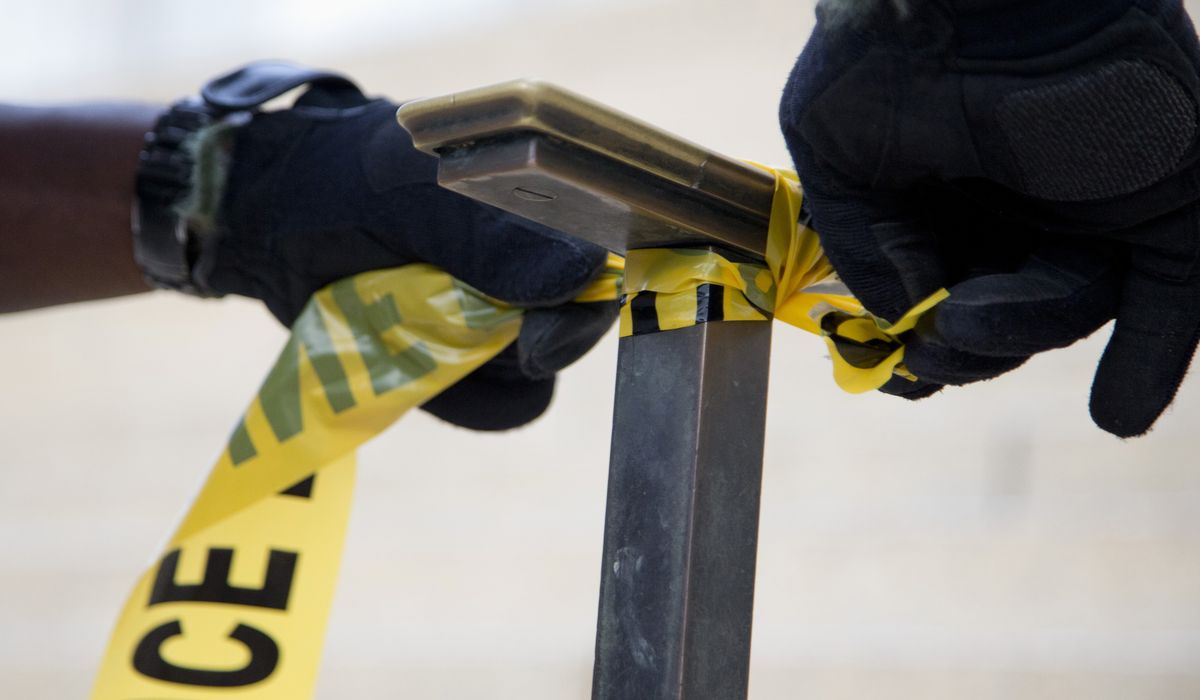
A man was shot dead in a residential neighborhood in Southeast Washington on Monday, marking the 225th homicide this year in the nation’s capital as the city approaches the most killings recorded since 2003.
“We have a homicide crisis, a policing crisis and a crisis at our jail,” local criminal defense attorney Patrice Sulton told The Washington Times.
With just a few days left in 2021, homicides in the nation’s capital are up 14% from the same time last year when 197 were recorded, the most since 248 in 2003.
Ms. Sulton, founder of the nonprofit D.C. Justice Lab, says the Metropolitan Police Department needs to reevaluate its priorities to stem the slayings.
“Our local police department is concerning itself too much with how many people it arrests and how much contraband it seizes,” she said. “We need them to refocus on preventing people from resorting to violence.”
D.C. Police Union President Greggory Pemberton, however, argues the city’s rising homicides are directly correlated to the understaffed police force, which has lost at least 300 rank-and-file officers since last year.
“The way to fix this is to immediately begin hiring as many officers as the academy can handle,” Mr. Pemberton told The Times.
Earlier this month, Mayor Muriel Bowser said she is “throwing every resource at the rise in violent crime” by expanding the city’s violence prevention outreach program into more neighborhoods. The mayor, a Democrat, has also added more “violence interrupters” — employees of the District’s Office of Neighborhood Safety and Engagement who “respond to critical incidents and facilitate peacemaking efforts” in parts of the city prone to gun violence.
The District is not alone. Other parts of the National Capital Region are grappling with homicide rates hitting levels that some communities have not seen in more than a decade.
In the last three months, Montgomery County, Maryland, recorded its 35th homicide, the most since 34 were recorded in 1994. Prince George’s County eclipsed 100 homicides for the first time since 2008, and Baltimore surpassed 300 for the seventh year in a row. Meanwhile, Richmond, Virginia, recorded its 90th homicide, the most since 95 in 2004.
The region is a microcosm of the rise in homicides across the country that began last year and “has extended deep into 2021 — though at a slower pace,” according to Ernesto Lopez, research specialist for the nonprofit Council on Criminal Justice.
FBI statistics show that homicides jumped by nearly 30% last year compared with 2019, from 16,669 to 21,570 — the single highest annual increase since the bureau began tracking the data 60 years ago.
A report last month by the Council on Criminal Justice shows that the number of homicides in 22 cities was 4% higher during the first nine months of this year than in the same period in 2020 and 36% higher than in 2019.
Patrick Yoes, president of the National Fraternal Order of Police, said “ongoing stresses and anxiety brought on by the coronavirus pandemic and the increased strain on relationships is one reason why violence is escalating.”
“Just as we have seen extreme anger and division on social media, it is having real-world consequences — a verbal argument or confrontation escalates into physical or deadly violence much more quickly,” Mr. Yoes said.
Police, activists and politicians can try to blame each other or pinpoint the exact causes fueling the deadly trend, but Mr. Lopez said no single factor is responsible for the spike.
“A combination of factors are likely in play — the impacts of COVID-19 on communities and law enforcement, the widespread unrest following the murder of George Floyd and the increasing use of guns in violent crimes,” he said.
With just days left in the current year, 2021 is poised to break last year’s records.
At least a dozen major cities have already counted more homicides this year than last. Los Angeles has had a 13% year-to-date increase in homicides, from 338 to 382. Homicides in Houston are up 14%, from 401 to 467, and homicides are up 4% in Chicago, from 763 to 794.
Another dozen major cities have set records. Philadelphia broke its homicide record of 501 set in 1990. Indianapolis broke its homicide record of 215 set last year, and Portland, Oregon, broke its record of 67 set in 1987.
Mr. Lopez says serious violence is concentrated among “remarkably small groups of people and places.”
“So cities should begin by conducting a rigorous analysis of their crime problem to identify the networks driving violence locally,” he said. “From there, they should develop a plan based on research showing what actually works to reduce violence and ensure that law enforcement and community-led organizations work together to carry it out.”
The bloodshed blame game also has to end.
“Violence reduction has to be a collaborative effort, driven by a shared vision of the problem and the solutions,” he said.
This story has been updated to reflect the Washington Metropolitan Police Department‘s reclassification of a fatal shooting in the District on Tuesday from homicide to suicide.








